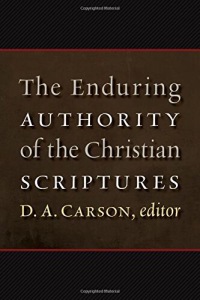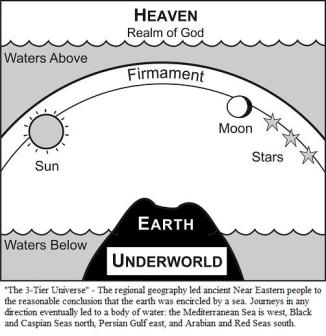This week and next, I will post my review of the massive volume, The Enduring Authority of the Christian Scriptures, edited by D.A. Carson. This week we will start with an overview and the positives of this work while next week I’ll cover what I consider some important weaknesses along with some brief concluding remarks.
 The Enduring Authority of the Christian Scriptures (Edited by D.A. Carson. Grand Rapids, Michigan : Eerdmans Publishing Company, 2016) sets out to provide, in one rather large volume (over 1200 pages!), a defense of, not so much the authority of the Christian Scriptures, but of their inerrancy. The book contains numerous essays on Historical, Biblical, Theological, Philosophical and Epistemological topics, along with a handful of essays regarding Comparative Religions as it relates to the authority of the Bible. In the introduction, which in itself contains a wonderful bibliography of non inerrantists’ works, the editor, D. A. Carson, surveys a wide variety of fairly recent (and some not so recent) monographs on the nature of the Bible. His overarching concern seems to be that these recent works “go beyond” the fundamentals of the doctrine of scripture and “for better or for worse, break fresh ground” (Kindle location 383; all locations are Kindle locations unless otherwise noted), which I take to mean denying inerrancy.
The Enduring Authority of the Christian Scriptures (Edited by D.A. Carson. Grand Rapids, Michigan : Eerdmans Publishing Company, 2016) sets out to provide, in one rather large volume (over 1200 pages!), a defense of, not so much the authority of the Christian Scriptures, but of their inerrancy. The book contains numerous essays on Historical, Biblical, Theological, Philosophical and Epistemological topics, along with a handful of essays regarding Comparative Religions as it relates to the authority of the Bible. In the introduction, which in itself contains a wonderful bibliography of non inerrantists’ works, the editor, D. A. Carson, surveys a wide variety of fairly recent (and some not so recent) monographs on the nature of the Bible. His overarching concern seems to be that these recent works “go beyond” the fundamentals of the doctrine of scripture and “for better or for worse, break fresh ground” (Kindle location 383; all locations are Kindle locations unless otherwise noted), which I take to mean denying inerrancy.
As others have remarked, it is telling that the book does not start by developing a doctrine of scripture, but rather dedicates the first section to looking at the historical development of the authority of Scripture within the church in an attempt to show that church luminaries throughout history not only understood the Scriptures as authoritative, but inerrant. This is indicative of what the book is: An attempt to defend a predetermined understanding of the nature of Scripture, namely Inerrancy. However, this is not simply The Battle for the Bible redivivus; the essays in this volume attempt to bring fresh insight into current debates about the nature and importance of biblical authority usually in the form of inerrancy. For those who already agree with this understanding of Scripture, it will be a welcomed addition to their library. However, it almost feels like a lost opportunity to look at just what does the Bible claim for itself, how has that been understood in the past and how might we understand those claims today. As a result, for those with differing views on the nature of scripture, even those who hold to a high, but not necessarily inerrant view, the essays will often be found lacking in evidential support, sound argumentation, or both.
First the positives
Overall, this compendium of essays brings together a variety of voices, not all of whom appear to agree with each other. This is to be admired for a volume whose chief purpose is defensive. Hill’s essay on Scripture in the Patristic Period, Lane’s on Catholic perspectives since Vatican I, Vanhoozer’s on whether we may move beyond the text and Rea’s on Authority and Truth were especially insightful. Also helpful for non-specialists is Glaser’s essay on Qur’anic Challenges for the Bible Reader in the Comparative Religions section. One of the more interesting aspects of this work as a whole is that some of the individual authors seem to distance themselves from particular aspects of inerrancy as defined in the Chicago Statement on Biblical Inerrancy. For instance, Webb’s essay on “Biblical Authority and the Diverse Literary Genres” acknowledges inner-canonical contradictions (or “tensions,” in his words) between James and Paul, something that, on the surface at least, challenges “the unity and internal consistency of Scripture” spelled out in Article XIV of the CSBI.
We will begin our more detailed look at specific essays with Charles E. Hill’s chapter, “’The Truth Above Demonstration’: Scripture in the Patristic Period to Augustine” which gives a very helpful overview of how the church fathers viewed scripture. This essay is full of helpful quotes from the primary sources. In it, he acknowledges that Origen, a very influential early church father, believed there were errors, at least as it relates to history and some facts, in the Scriptures. It is very helpful for Hill to acknowledge what appear to be contradictions to the belief that the church has always understood the Scriptures as inerrant. Hill then attempts to explain this contradiction by looking at Origen’s larger theological project, that of delving into the “spiritual realities” of the Scriptures. According to Origen, “A desire to showcase the benefits of spiritual exegesis can open one’s eyes to literal contradictions where others may not see them” (1977-1978). In essence, Hill seems to be saying that Origen understood there to be errors based on his “Spiritual” hermeneutic but it seems that perhaps the reverse is true: That Origen developed his spiritual/allegorical hermeneutic in response to what he perceived to be errors in the narrative of the text. Still, overall Hill’s essay does an excellent job of surveying the early church fathers and their views on the authority of the Scriptures, if not necessarily connecting that authority to inerrancy.
Bookending Hill’s essay in the Historical Topics section is a fine summary of Roman Catholic thought by Anthony N. S. Lane, “Roman Catholic Views of Biblical Authority from the late Nineteen Century to the Present.” After a brief overview of Trent, in which he highlights the importance of changes made from the early drafts where the final draft removed the word “partly” from the clause, “partly in written books, partly in unwritten traditions” (9401), Lane goes on to give a thoroughly helpful overview of the formal development of Catholic thought regarding Scripture from Vatican I (c. 1870) through the end of the 20th century. The bulk of his essay, however, focuses on one of the dogmatic constitutions from the Second Vatican Council, Dei verbum (c. 1965). Lane helpfully notes that official church teaching spelled out in Dei Verbum contradicts Protestant assertions that Catholics subordinate the Bible to the teaching office. More importantly, apparently under the influence of Hans Küng, it moved the church away from more dogmatic approaches to Scripture. The next section covers the commemorative work, The Interpretation of the Bible in the Church (c. 1993), in which Lane reviews how the changes represented in Dei Verbum, especially the new found emphasis on the “genuine human authorship” of the Bible, freed Catholic scholars to employ critical methods that are usually considered anathema by Fundamentalists. (And I would add, to many of the gatekeepers of Evangelicalism, including some of the authors in this volume.) Overall, this essay gives a very informative overview of recent Roman Catholic work and dispels several protestant misunderstandings, making it a worthwhile read in itself.
I found the essays in the Biblical and Theological section to be largely bland and sometimes even outright unhelpful. An exception to this is Kevin J. Vanhoozer’s chapter, “May We Go Beyond What Is Written After All? The Pattern of Theological Authority and the Problem of Doctrinal Development.” In this essay he seeks to do several things. One, he makes a case for the on-going task of constructive theology, what he refers to as Christian Doctrine. Second, he encourages a movement beyond what he calls naïve biblicism (which he claims is actually the target of Christian Smith’s The Bible Made Impossible) and accept instead a “critical biblicism” (emphasis his). He then seeks to delineate ways that we can move beyond the text “with a limited degree of extrapolation” (23859), while still putting boundaries on that movement. Vanhoozer spends the remainder of this essay spelling out how this could be done, using a narrative, or (theo)dramatic context. This approach will likely resonate with readers of N. T. Wright. Vanhoozer’s essay is thoughtful and worth reading more than once.
Some of the most interesting essays were among the Philosophical and Epistemological Topics. R. Scott Smith’s essay, “Non-Foundational Epistemologies and the Truth of Scripture” points out that there are many foundationalisms, so at the very least, critics must be willing to define what they are critiquing when it comes to foundationalism (which he claims neither Grenz nor Franke do in their works). Smith shows a willingness to move toward a soft foundationalism, although his overarching concern seems to be that we can know reality in itself accurately, albeit not exhaustively, as opposed having simply “our interpretations or conceptualizations” of reality (26560-26561). His primary exemplar for the need to maintain some sort of foundationalism is Paul’s (so-called) conversion. He says that Paul’s “Pharisaical grid” could not have provided the framework for Paul to come to know Jesus as Lord without somehow coming to see “Jesus for who he truly is” (26566-26567). The concern is that “if we cannot access reality (even Scripture) directly, albeit in ways that are accommodated to our finite minds, we will not know reality” (26559-26560). But this seems to break down in at least two important ways. First from the biblical witness, it appears that at least Nicodemus, with a similar Pharisaical interpretive grid, also became a follower of Jesus (John 3:1-10, 7:50, 19:39) so this supposed interpretive grid did indeed provide the necessary conceptual framework. Second, from a linguistic standpoint, cognitive linguistics points to all language being metaphor so that we don’t have any way to interpret reality, except through conceptualization. It’s ironic in a way, then, that in an essay on epistemology, Smith’s foundational assumptions here seem inadequately grounded. All that said, I still found this essay very helpful in attempting to spell out a more chastened foundationalism.
Probably one of the most profound chapters in this volume, and one that non-inerrantists and inerrantists may read quite differently, is Michael C. Rea’s “Authority and Truth.” In this essay, Rea argues that authority and truth do not need to be inherently linked, but instead, it depends on the domain in which the text is authoritative and the centrality of the errors to the main subject of the text. “No ascription of authority to a text is complete without the specification of the domain within which it has authority” (27014). Indeed, if this is the case “then no text — and certainly not the Bible — is authoritative simpliciter” (27010-27011), meaning authoritative in everything. He then goes on to discuss different kinds of authority (practical and theoretical), what makes something or someone an authority and authority defeaters. “Authorities are sources of information or directives” (27032-27033). Authorities are defeated when we have conflicting authorities. In other words, we come to learn that one authority has priority over another. For example, if I say a particular Hebrew word means X and you go look it up in the dictionary and it says, Y, then you are more likely to give the dictionary priority over me. (Which is not to say I may not be correct, but simply that by default, an academic Lexicon has priority.)
The next section of this essay covers truth. After a very brief acknowledgement that defining truth is much too unwieldy for such a short essay, Rea goes on to give a high level overview of some of the categories in the literature (realist/anti-realist, epistemic/non-epistemic and correspondence theories vs. everything else). Here we get to some of the key questions of the essay: How can a text can be considered true if it contains falsehoods? His answer: If “the falsehoods simply aren’t central — that is, they are not part of ‘the most important message’ of the text,” then they do not falsify the text (27417-27418). This, of course, requires that we must be skillful interpreters of the text in order to determine what the central message is, as well as the domain in which it exercises authority. Rea then draws six conclusions, which I will quote at length:
- To say without qualification that a text is authoritative is to say nothing definitive about whether it is true. (27439-27440)
- if a text has theoretical authority over an individual in some domain, then the text’s assertions within that domain must be reliable enough to warrant belief in the absence of defeaters (27452-27454).
- if a text has foundational theoretical authority over S in D, then it must be at least as reliable as any other authority for S in D (27465-27466).
- (β) G is the author of the Bible, and, necessarily, for any text τ authored by God and for any individual S other than God, τ has foundational authority over S in the domain defined by the text itself (27496-27498). If God is the author β implies that the Bible is perfectly reliable within the domain defined by the text itself. Thus, if β is true, then every proposition that the Bible semantically asserts or intentionally conveys must be true, and all of its directives constitute decisive reason for action (27499-27501).
- it is not clear that any (non-question-begging) assumption weaker than β will forge the same link between authority and inerrancy. We have already seen that a text can be foundationally authoritative for an individual in a domain without being perfectly reliable in that domain (27522-27524). So it seems that those interested in maintaining a connection between scriptural authority and scriptural inerrancy will be best served by devoting their philosophical-theological energies to a defense of β (27527-27529).
- Our views about the nature and scope of biblical authority shed, all by themselves, relatively little light on the most interesting questions about the truthfulness of problematic passages in Scripture. Consequently, it is a mistake to treat the topic of biblical authority as somehow lying at the heart of debates about the reliability and inerrancy of Scripture. Far more pertinent to these latter debates are questions about the nature of God and divine authorship: In what sense is God an (or the) author of Scripture? What are God’s aims in Scripture? What might be God’s aims in this or that part of Scripture? Is God the sort of author about whom β is true? (27540-27545, emphasis added).
This has important ramifications for the nature of authority. First off, we can see that authority need not be tied to inerrancy, as is done in so many of the essays. Second, it leaves the door open on how to understand the Bible as authoritative but not necessarily inerrant although I’m not sure that was Rea’s intention. But if, say Genesis, is not meant to be authoritative in the scientific domain, then reading Genesis 1 as a type of etiological poetry would not weaken the authority of Scripture, contrary to Article XII in the CSBI (“We deny that Biblical infallibility and inerrancy are limited to spiritual, religious, or redemptive themes, exclusive of assertions in the fields of history and science. We further deny that scientific hypotheses about earth history may properly be used to overturn the teaching of Scripture on creation and the flood.”)
All in all, I have devoted the most time to this essay because I think it provides the philosophical groundwork on how to understand a non-essential correspondence between authority and inerrancy. Next week we will proceed to some of the less satisfying essays in the book.
What are your thoughts? Does the Bible have to be inerrant to be authoritative? Does a high view of Scripture necessarily entail inerrancy?


![See page for author [Public domain], via Wikimedia Commons damascus_pentateuch](https://upload.wikimedia.org/wikipedia/commons/1/1d/Damascus_Pentateuch.png)

